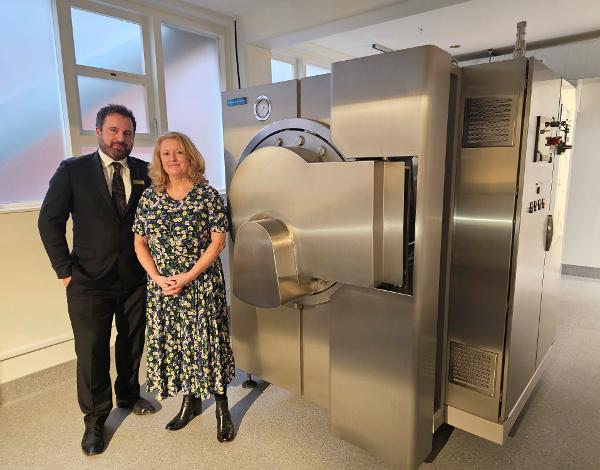Hundreds Attend Open Day At New Zealand's Only Water Crematorium
Interested members of the public lined up half an hour before opening at the country’s first water crematorium last Saturday.
With a 1pm start time for the inaugural open day at the Christchurch Water Crematorium, the queue snaked around the building and along the Bell, Lamb and Trotter frontage on St Asaph Street
Co-director of the crematorium, Deborah Richards, says she was delighted with the interest which shows that the more environmentally friendly form of cremation is definitely piquing interest.
“We really didn’t know how many people would come and we had just over 300 through in three hours which was fantastic,” she says. “The most common response I heard from visitors about being water cremated was, “why wouldn’t you?” It’s the environmental positives that seemed to be the main appeal to people, followed by seeing water as a gentler way to cremated and being able to rent a casket,” says Deborah Richards. “Many loved the New Zealand wool shrouds we use as well.”
Christchurch Water Crematorium is the result of a partnership between one of the country’s oldest and most respected funeral service providers, Bell, Lamb and Trotter, and one of the newest innovators in New Zealand, Water Cremation Aotearoa,
Officially opened on 6th June, water cremation is quickly establishing itself as a choice alongside the already well-established options of flame cremation and burial. Also called Alkaline Hydrolysis or resomation, water cremation is a nature-based solution where no carbon is emitted during the water cremation process which leaves a sterile liquid with no DNA in at all.
That is then returned to the water cycle. Anything not of the body – such as pacemakers and implants -remain behind, clean and intact, and can be recycled. The bones that remain after the process is complete can be returned to the family as bones or white ash, it is their choice.
Bell, Lamb and Trotter Managing Director and Christchurch Water Crematorium Co-director Andrew Bell, says there’s a demand for environmentally friendly options in life so it’s pleasing to be able to offer such options in death.
“Bell, Lamb and Trotter was the first company in the country to introduce embalming in 1896 and then flame cremation became available in 1909 which is probably the last time something so noteworthy has happened in the funeral services sector,” he says. “We are getting inquiries from all over the country and we have been very busy since our June opening.”
-Ends-
Note: It is estimated that one traditional flame cremation produces an average of 242 kgs of carbon dioxide* which is roughly the same as driving an average, petrol car from Christchurch to Cape Reinga at the top of the North Island.
*The average vehicle in New Zealand has Co2 emissions of around 171 grams per kilometre (g/km), therefore the Co2 emissions from one traditional cremation is (242kgs = 242000gms), is the equivalent of driving 1415.2 km in an average petrol vehicle; roughly the same as driving from ChCh to Cape Reinga in an average, petrol car.
Frequently asked questions (FAQs):
What is Water Cremation?
Water Cremation is an alternative for flame cremation. It has been used by funeral homes all over the world since the early 21st century.
Instead of using flame generated by fossil fuels, water cremation uses water and an alkaline solution (potassium hydroxide) under pressure to mimic and speed up the natural process the body goes through when it is buried.
Using a Resomator, which is about the size of small car, a body is placed inside, usually in a biodegradable shroud (wool, silk), the natural process is reduced to around 4-5 hours instead of decades.
There is no carbon emitted in the Resomation process itself.
Anything not of the body – such as pacemakers and implants remain behind, clean and intact, and can be recycled. The bones that remain after the process is complete can be returned to the family as bones or white ash, it is their choice. There is slightly more ash resulting from a water cremation than a flame cremation.
Is there a casket at a water cremation?
Only biodegradable material may be placed in the Resomator. Silk or wool is often used as a shroud for the loved one and this too is broken down in the resomation process. A casket can be used prior to the resomation itself.
What temperature is the cremation?
A water cremation uses water at a temperature of 150 degrees Celsius (to create steam). That compares with temperatures between 850 and 1100 degrees Celsius for flame cremation.
Additional:
Bell, Lamb and Trotter was established in Christchurch in 1872, the first funeral directors to bring embalming to New Zealand. Flame cremation was introduced to New Zealand in 1909.
Archbishop Desmond Tutu (died in 2021) chose water cremation due to its environmental benefits.
There were 37,647 deaths in New Zealand to end of March 2025 (stats.govt.nz). Around 70% of people are cremated (2022 figs).
Christchurch Water Crematorium is located at Bell, Lamb and Trotter, 420 St Asaph Street.

